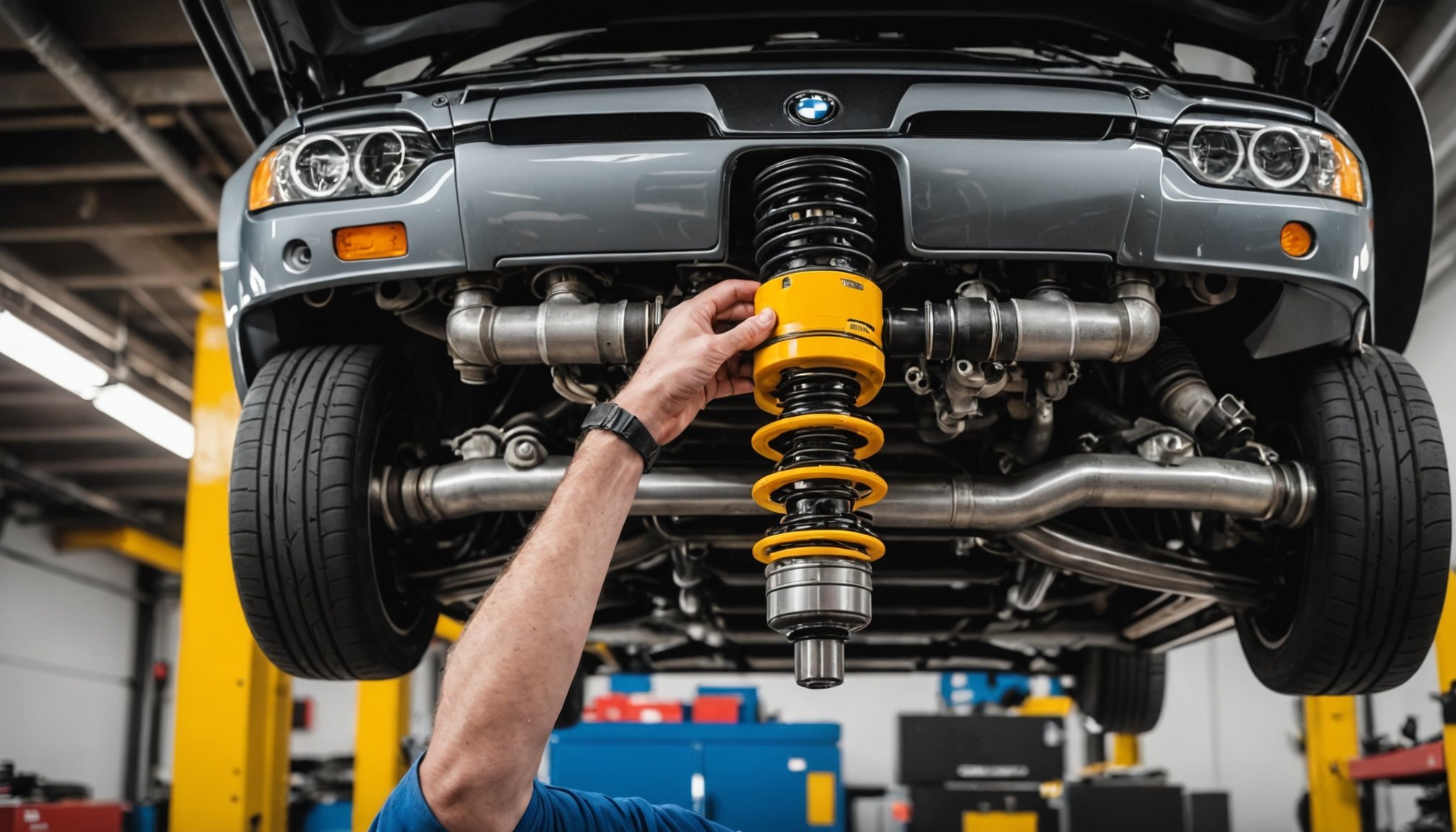Ultimate Guide to Coilover Installation and Fine-Tuning for Your BMW M3: Step-by-Step Instructions for Maximum Performance
Why Coilovers are a Game-Changer for Your BMW M3
When it comes to enhancing the performance and handling of your BMW M3, one of the most significant upgrades you can make is installing a high-quality coilover suspension kit. Coilovers offer a level of adjustability and precision that stock suspension systems simply can’t match, making them a favorite among both track enthusiasts and everyday drivers looking to improve their car’s ride and handling.
“Coilovers are essentially the heart of your suspension system,” says a seasoned mechanic from European Auto Source. “They allow you to fine-tune every aspect of your car’s ride, from the height and damping to the overall handling characteristics. It’s like giving your car a new personality.”
This might interest you : Transform your mercedes-benz glc: the ultimate guide to installing a high-tech digital rearview mirror for enhanced visibility
Choosing the Right Coilover Kit for Your BMW M3
Before you dive into the installation process, it’s crucial to select the right coilover kit for your BMW M3. Here are some key factors to consider:
Vehicle Compatibility
Ensure the coilover kit is specifically designed for your BMW M3 model. For example, the Nitron NTR R1 2-Way Coilover Suspension Kit is tailored for the BMW G8X M3/M4, including the Competition models[3].
Also to read : Transform your honda cr-v: a comprehensive guide to upgrading your infotainment system for a modern experience
Damping Adjustment
Look for coilovers with adjustable damping. The Nitron NTR R1, for instance, offers 2-way combined damping adjustment, allowing you to tweak both rebound and compression damping to suit your driving style[3].
Spring Rates
Choose coilovers with spring rates that match your driving needs. For a balance between road and track use, the Nitron NTR R1 comes with front spring rates of 343 lbs-in and rear spring rates of 225 lbs-in[3].
Additional Features
Consider coilovers with additional features such as Front Axle Lift (FAL), which allows for instant lifting of the vehicle to clear obstacles like driveways and trailer ramps[3].
Step-by-Step Installation Guide
Installing coilovers is a significant undertaking, but with the right tools and a bit of patience, you can achieve professional results. Here’s a detailed step-by-step guide:
Preparation
- Gather Tools and Materials: Ensure you have all the necessary tools, including a lift, jack stands, and a torque wrench.
- Consult the Manual: Read through the installation manual provided with your coilover kit to understand the specific requirements.
Removing the Old Suspension
- Raise the Car: Use a lift or jack stands to raise the car, ensuring it is securely supported.
- Remove the Wheels: Take off the wheels to access the suspension components.
- Disconnect the Struts: Carefully disconnect the struts from the steering knuckle and the lower control arm.
- Remove the Springs and Mounts: Remove the old springs, mounts, and any other components that need to be replaced.
Installing the New Coilovers
- Install the Coilover Struts: Mount the new coilover struts, ensuring they are properly aligned and secured.
- Install the Springs: Place the new springs onto the coilover struts, following the manufacturer’s instructions for proper seating.
- Reconnect the Components: Reconnect the coilover struts to the steering knuckle and the lower control arm.
- Replace the Wheels: Put the wheels back on and lower the car to the ground.
Initial Adjustment
- Set the Ride Height: Adjust the ride height to your desired level. Most coilover kits are height adjustable, allowing you to fine-tune the height to suit your needs[3].
- Check the Alignment: Ensure the car is properly aligned after the installation to avoid any uneven tire wear.
Fine-Tuning Your Suspension for Maximum Performance
Fine-tuning your suspension is where the real magic happens. Here are some tips to help you get the most out of your coilovers:
Damping Adjustment
- Rebound Damping: Adjust the rebound damping to control how quickly the suspension returns to its original position after a bump. Higher rebound settings can help reduce body roll but may make the ride stiffer.
- Compression Damping: Adjust the compression damping to control how the suspension compresses when hitting a bump. Higher compression settings can improve handling but may make the ride harsher.
Spring Rates
- Front and Rear Balance: Ensure the spring rates are balanced between the front and rear to maintain even handling characteristics.
- Track vs. Road Use: If you plan to use your car on the track, you may want stiffer spring rates for better handling. For road use, softer spring rates can provide a more comfortable ride.
Ride Height
- Lowering the Car: Lowering the car can improve handling by reducing the center of gravity, but be cautious not to go too low, as this can affect ground clearance and increase the risk of scraping.
- Clearance: Use features like Front Axle Lift (FAL) to ensure you can clear obstacles without damaging your car[3].
Practical Insights and Actionable Advice
Here are some practical tips and advice to keep in mind when installing and fine-tuning your coilovers:
Maintenance
- Regular Checks: Regularly check the coilovers for any signs of wear or damage. Ensure all bolts and nuts are tightened to the specified torque.
- Serviceability: Choose coilovers that are fully serviceable, like the Nitron NTR R1, to ensure maximum longevity[3].
Driving Experience
- Test and Adjust: After installation, take your car for a test drive to feel how it handles. Make adjustments as needed to achieve the perfect balance between comfort and performance.
- Log Your Adjustments: Keep a log of your adjustments so you can track what works best for your car.
Comparison of Popular Coilover Kits for BMW M3
Here is a comparison table of some popular coilover kits for the BMW M3:
| Coilover Kit | Damping Adjustment | Spring Rates | Additional Features | Price |
|---|---|---|---|---|
| Nitron NTR R1 | 2-Way Combined | F: 343 lbs-in, R: 225 lbs-in | Front Axle Lift (FAL) | €6,911.95[3] |
| KW Variant 3 | 2-Way Combined | Adjustable | No FAL | Around $3,000 |
| Öhlins Road & Track | 2-Way Combined | Adjustable | No FAL | Around $4,000 |
| Bilstein B16 | 2-Way Combined | Adjustable | No FAL | Around $2,500 |
Detailed Bullet Point List: What to Consider When Fine-Tuning Your Coilovers
-
Ride Height:
-
Ensure the car is level and the ride height is evenly set.
-
Use a ruler or measuring tape to check the height.
-
Adjust the coilovers to achieve the desired height.
-
Damping Adjustment:
-
Start with the manufacturer’s recommended settings.
-
Adjust rebound and compression damping separately.
-
Test drive the car and make adjustments based on how it handles.
-
Spring Rates:
-
Balance the spring rates between the front and rear.
-
Consider stiffer spring rates for track use and softer rates for road use.
-
Ensure the spring rates are compatible with your driving style.
-
Alignment:
-
Check the alignment after adjusting the ride height.
-
Ensure the car is properly aligned to avoid uneven tire wear.
-
Maintenance:
-
Regularly check the coilovers for signs of wear or damage.
-
Ensure all bolts and nuts are tightened to the specified torque.
-
Service the coilovers as recommended by the manufacturer.
Quotes and Anecdotes
“Fine-tuning your coilovers is an art,” says a BMW enthusiast from the Bimmerpost forum. “It takes patience and a good understanding of how each adjustment affects the car’s handling. But when you get it right, it’s like driving a completely different car.”[4]
“I installed the Nitron NTR R1 coilovers on my BMW M3 and it transformed the driving experience,” notes another owner. “The adjustable damping and Front Axle Lift feature have been game-changers for both road and track use.”[3]
Installing and fine-tuning coilovers for your BMW M3 is a rewarding process that can significantly enhance your car’s performance and handling. By choosing the right coilover kit, following a detailed installation guide, and fine-tuning the suspension to your needs, you can achieve a driving experience that is both exhilarating and comfortable.
Remember, the key to maximum performance is in the details – from the initial installation to the ongoing adjustments and maintenance. With the right approach, your BMW M3 can become a true handling marvel, whether you’re carving through mountain roads or dominating the track.











